- SEO SWOT analysis organizes internal factors (technical health, content authority) and external factors (competition, trends) for strategic planning.
- Its primary purpose is to align SEO with business goals, prioritize high-impact actions, and enable proactive strategies.
- A structured process includes defining KPIs, categorizing strengths, weaknesses, opportunities, threats, and building a prioritized, actionable roadmap.
Every successful SEO strategy begins with clarity. Before allocating resources, launching content initiatives, or optimizing for Core Web Vitals, businesses need a structured method to evaluate where they stand and where they can go. One of the most reliable strategic tools for achieving this, whether you are performing an internal review or an SEO company SWOT for clients, is an SEO SWOT analysis. Unlike routine audits that often produce a list of technical fixes, a website SWOT analysis paired with a SWOT analysis in SEO provides a complete, actionable picture of SEO performance within the context of the market and competitors.
An SEO SWOT analysis brings structure to an otherwise fragmented SEO landscape. By organizing internal factors such as technical health and content authority alongside external factors like competitive threats and emerging opportunities, organizations can make informed decisions that align with broader marketing objectives. For expert practitioners, this method goes beyond checklists. It acts as a strategic compass for decision-making in dynamic search environments.
This article explores what an SEO SWOT analysis entails, why it is essential for high-level SEO strategy, and how to perform it with precision. It also covers advanced applications, common pitfalls, and real-world examples. This is not an elementary guide; it is designed for professionals seeking to integrate analytical rigor into their SEO decision-making processes.
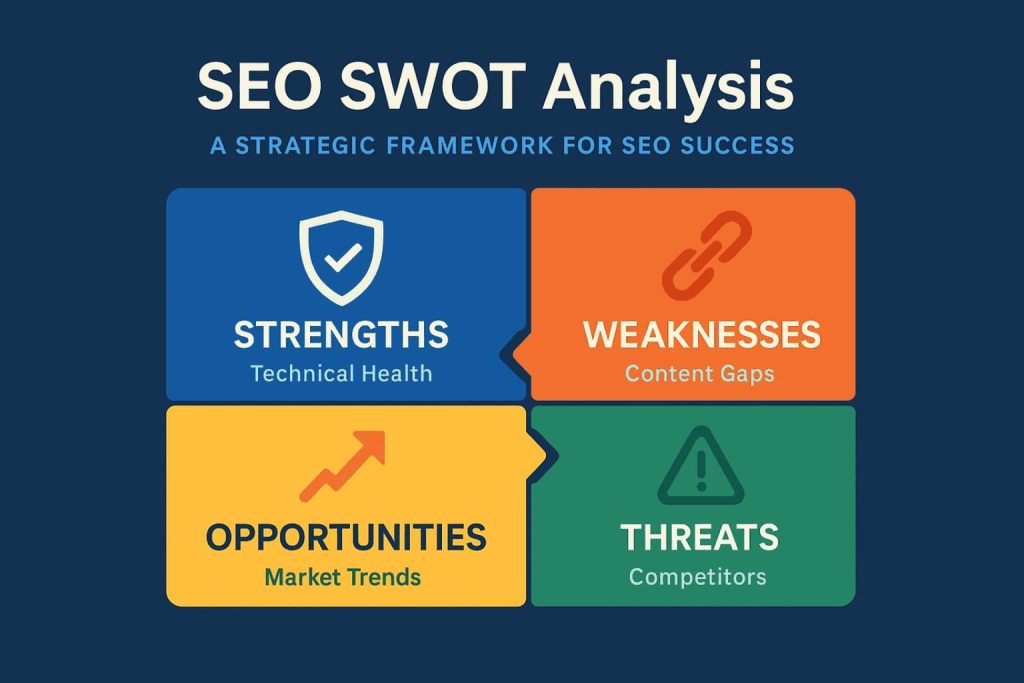
What is the Primary Purpose of SWOT Analysis in SEO?
The primary purpose of a SWOT analysis in SEO is to transform fragmented SEO data into a strategic roadmap for sustainable growth. It serves as a decision-making framework that transforms fragmented SEO data into a roadmap for sustainable growth. By breaking it down into specific objectives, we can understand why this methodology is essential for strategic SEO planning.
1. Align SEO With Business Goals
An SEO SWOT analysis ensures that your optimization efforts directly support business priorities. Instead of chasing vanity metrics like traffic spikes or ranking for irrelevant keywords, the framework emphasizes alignment with KPIs that matter, such as revenue, lead generation, and brand visibility. This alignment is where a Fractional CMO’s perspective adds value, connecting SEO execution directly to revenue and brand strategy.
For example, if your company aims to dominate a niche product category, the SWOT analysis helps focus on opportunities like optimizing long-tail keywords for high-intent queries, while addressing weaknesses like thin product descriptions that hurt conversions.
2. Move From Reactive to Proactive Strategy
Many SEO teams operate in a reactive mode, responding to traffic declines or algorithm updates after they occur. This approach leads to short-term fixes and wasted resources. The primary purpose of SWOT analysis in SEO is to break this cycle by creating a proactive plan.
By identifying potential threats such as rising competitor activity or SERP feature volatility, you can implement defensive strategies before your rankings are impacted. Similarly, opportunities like emerging keyword trends or new structured data types can be acted upon ahead of competitors.
3. Prioritize High-Impact SEO Actions
Not every SEO issue or opportunity carries the same weight. Without prioritization, teams risk spending months on low-value fixes while overlooking initiatives that drive real growth. SWOT analysis provides clarity by organizing insights into strengths, weaknesses, opportunities, and threats, making it easier to see which actions deliver the greatest impact.
For example:
- Implementing structured data on high-traffic pages might be a quick win with outsized returns.
- Redesigning site navigation could be high-impact but requires more resources and planning.
This balance allows decision-makers to allocate time and budget effectively, while keeping the focus on outcomes that matter most.
4. Enhance Competitive Positioning
SEO is not just about optimizing your own site; it is about outperforming competitors in search results. A well-executed SWOT analysis integrates competitive intelligence, identifying where rivals hold strengths (e.g., link authority) and where they are vulnerable (e.g., thin informational content).
The purpose here is not simply to observe competitors but to use this data for strategic positioning. For instance, if competitors dominate short-form content, producing comprehensive evergreen guides can help you capture higher-intent traffic.
5. Improve Cross-Department Collaboration
SEO rarely operates in isolation. Development teams handle technical changes, content teams create assets, and PR teams build authority signals. A clear SWOT framework communicates priorities across these functions, ensuring alignment. When stakeholders see that an opportunity (e.g., optimizing category pages) links directly to revenue targets, they are more likely to allocate resources promptly. Fractional CMOs excel at breaking silos ensuring SEO, product, and PR work together instead of in isolation.
6. Future-Proof SEO Investments
Google’s Search Generative Experience (SGE) and AI-driven search features are transforming how results are displayed. Instead of only ranking for blue links, businesses now need to anticipate how AI summaries, conversational answers, and zero-click SERPs impact visibility.
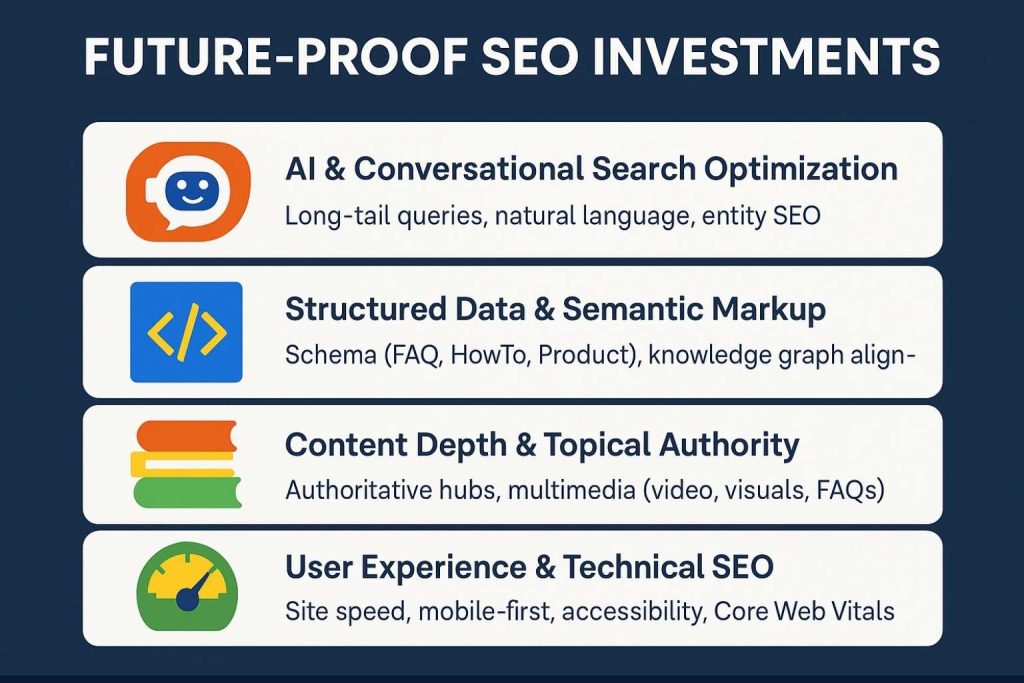
Here’s how to integrate SGE into your SWOT analysis:
Strengths
- If your site already produces comprehensive, authoritative content, it is more likely to be cited within AI-generated answers.
- Strong entity-based SEO (structured data, semantic markup, knowledge graph alignment) boosts your inclusion in AI responses.
Weaknesses
- Overreliance on short-form content that doesn’t provide depth makes your site less likely to be pulled into SGE summaries.
- Lack of multimedia formats (videos, visuals, FAQs) reduces your chances of being featured in diverse answer types.
Opportunities
- Optimize for conversational, long-tail queries that mirror how people ask questions in AI search.
- Expand structured data and schema coverage (FAQ, HowTo, Product) to increase your chance of being referenced in AI results.
- Create authoritative topical hubs that establish expertise in niche areas AI assistants prefer for source material.
Threats
- Zero-click AI summaries may reduce organic CTR for traditional rankings.
- Competitors investing early in AI-focused optimization may capture visibility in your keyword space.
- Rapid algorithmic shifts in how AI selects sources could undermine current strategies.
Treat SGE like a new SERP feature. Just as you optimize for featured snippets, People Also Ask, or video carousels, adapt your SEO SWOT to include AI search factors. Revisit this analysis quarterly to account for evolving AI-driven search behaviors.
7. Provide a Benchmark for Performance Measurement
Another primary purpose is to create a baseline for evaluating progress over time. A detailed SWOT analysis highlights your current position in terms of technical health, content authority, and competitive advantage. When repeated quarterly or biannually, it enables you to track improvements, validate strategies, and refine future roadmaps.
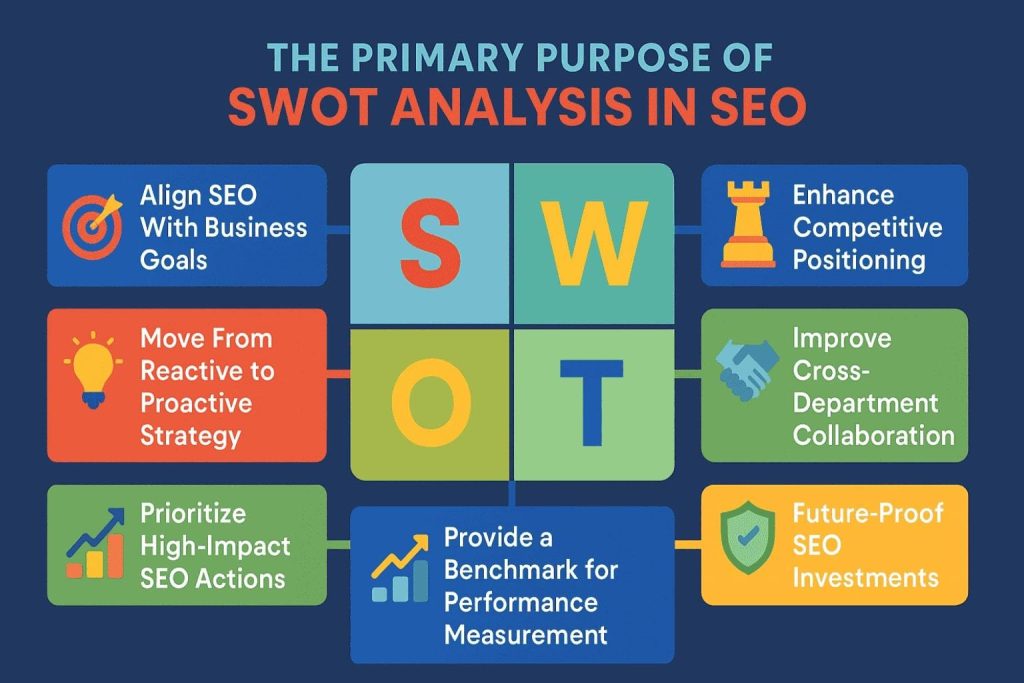
Why Conduct an SEO SWOT Analysis?
A common question raised by many professionals is, “Why not stick to audits and keyword research? Isn’t that enough?” The answer is no. While audits and research are essential, they operate in isolation. They identify what is broken or what to target, but they do not prioritize actions within the broader context of business objectives or competitive realities. This is precisely where a SWOT analysis adds strategic value.
Here are the key reasons why conducting an SEO SWOT analysis is essential:
1. Strategic Prioritization
Not all SEO tasks are equal. Fixing minor technical issues might improve site health, but expanding content around high-value intent keywords could yield far greater revenue impact. SWOT analysis helps you allocate resources to the actions that truly move the needle.
2. Competitive Awareness
SEO exists in a competitive environment. Your visibility depends on outperforming others targeting the same keywords. SWOT analysis forces you to analyze competitor strategies and identify areas where you can gain an advantage or defend your position.
3. Risk Management
Search engines evolve constantly. Google’s algorithm updates, changes in SERP layouts, and new ranking signals can impact performance overnight. By mapping potential threats, you can design contingency plans and diversify your strategies to reduce risk.
4. Business Alignment
Executives and stakeholders care about outcomes like revenue, leads, and brand authority, not just rankings. By connecting SEO actions to strategic objectives, you secure buy-in and budget more easily.
5. Long-Term Scalability
SWOT analysis is not static. When repeated regularly, it becomes a feedback loop that improves decision-making over time. Each cycle gives you historical context to refine future strategies.
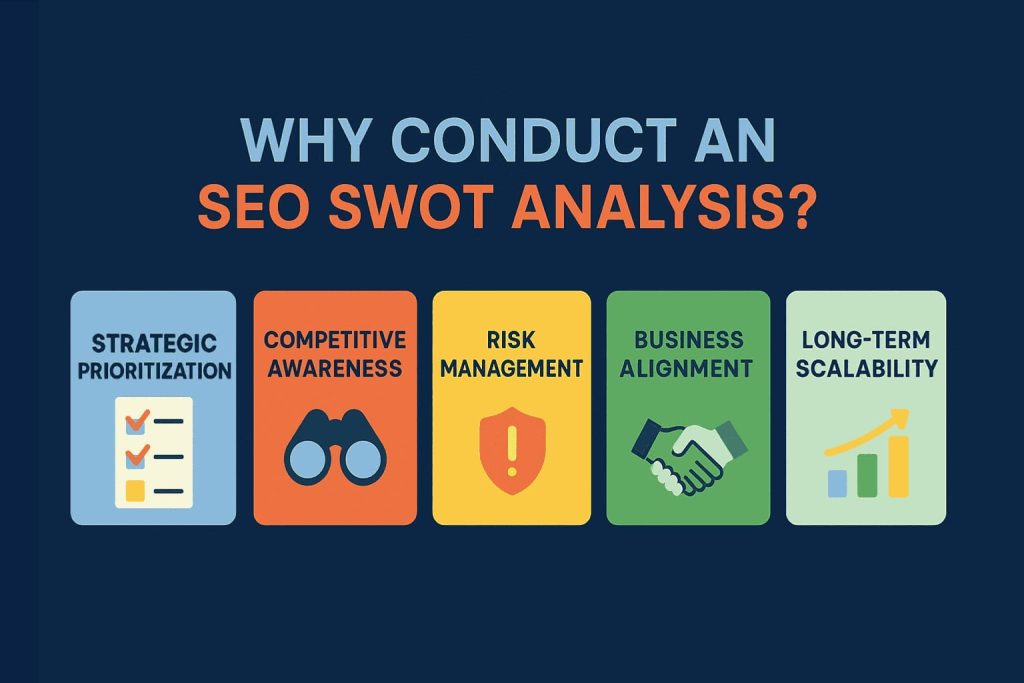
This structured thinking separates organizations that succeed with SEO from those that chase short-term wins.
Core Components of an SEO SWOT Analysis
Every SWOT framework consists of four quadrants: strengths, weaknesses, opportunities, and threats. When applied to SEO, these categories gain very specific meanings tied to performance metrics, technical health, and competitive dynamics. Let us break down each component with detailed examples and advanced considerations.
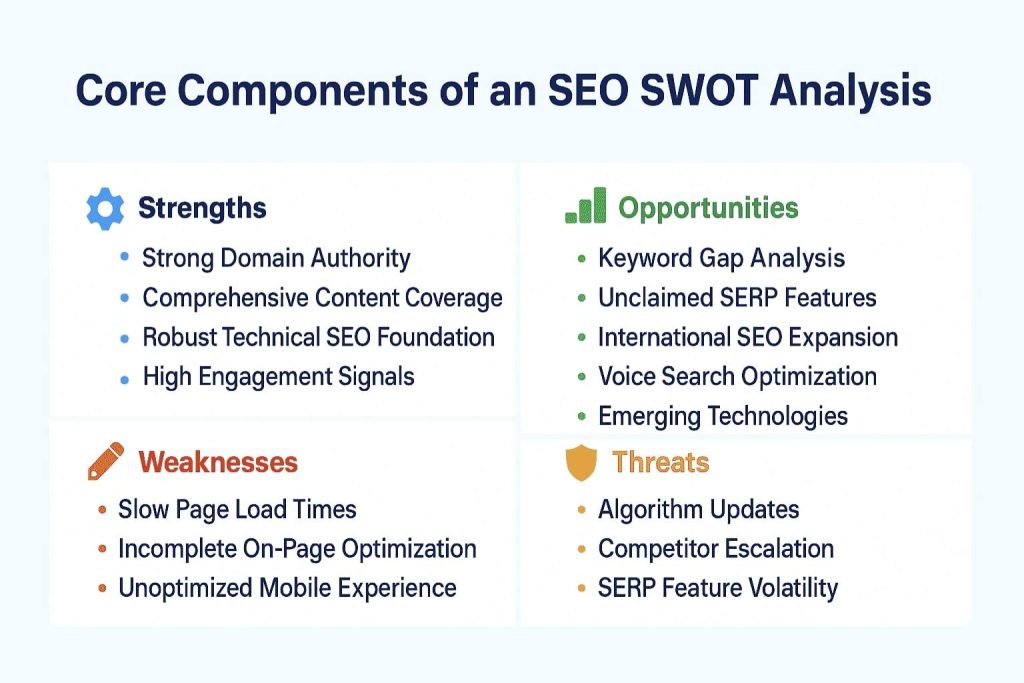
Strengths: Internal SEO Advantages
Strengths are the internal elements that give your website a competitive edge in organic search. They represent what you are already doing well. Identifying these correctly allows you to leverage them further and consolidate your advantage.
What Qualifies as a Strength in SEO?
- Strong Domain Authority: If your domain has high authority, as measured by tools like Moz Domain Authority or Ahrefs Domain Rating, you can target competitive keywords more aggressively.
- Comprehensive Content Coverage: If you already have strong topical clusters and high-quality evergreen content, you can capitalize on this to build deeper silos or create internal linking structures that boost authority.
- Robust Technical SEO Foundation: Fast-loading pages, efficient crawlability, and optimized mobile performance ensure that technical barriers do not limit rankings. Tools like Google Lighthouse help validate these.
- High Engagement Signals: Metrics such as CTR, dwell time, and low bounce rates indicate that users find your content relevant. This positively influences ranking signals over time.
How to Identify SEO Strengths
- Use Google Search Console to analyze top-performing pages and high CTR keywords.
- Check backlink quality with Majestic or Ahrefs to confirm authority-building assets.
- Benchmark site performance using Core Web Vitals reports for speed and interactivity.
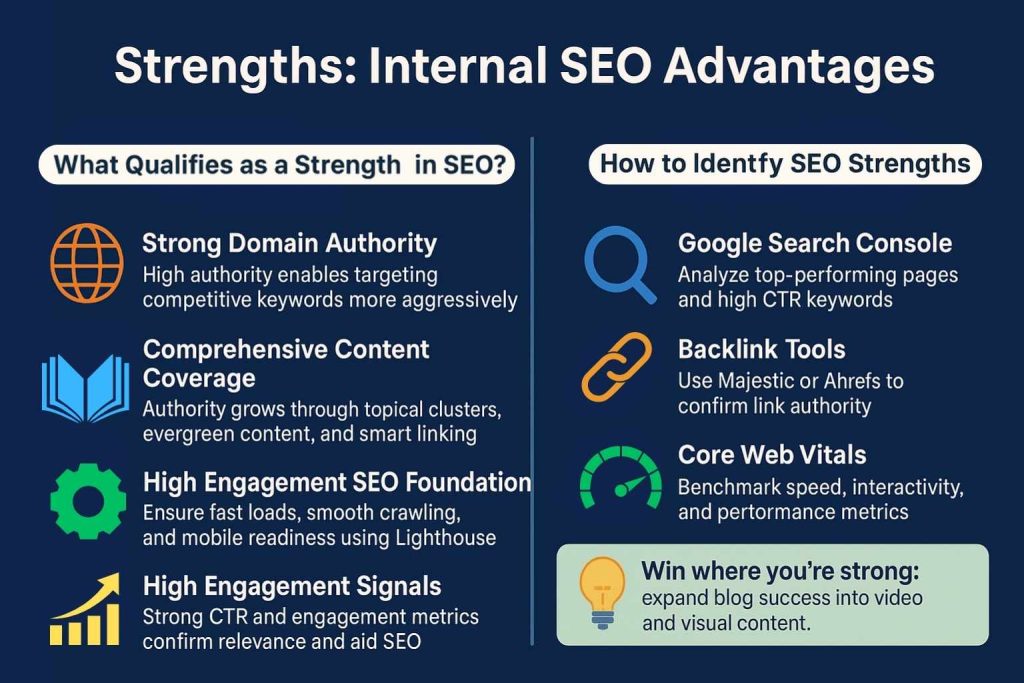
Recognizing strengths allows you to double down on areas where your site can dominate. For example, if your blog ranks well for educational queries in your niche, you can expand into video and visual content for additional SERP features.
Weaknesses: Internal SEO Limitations
Weaknesses are internal factors that hinder your ability to rank higher or capture more traffic. Unlike threats, which are external, weaknesses are within your control and should be addressed systematically.
Examples of Common Weaknesses
- Slow Page Load Times: Websites with poor performance fail to meet Google Page Experience standards, impacting rankings.
- Incomplete On-Page Optimization: Missing or duplicate title tags, thin content, and a lack of schema markup reduce relevance and visibility.
- Unoptimized Mobile Experience: Mobile-first indexing means sites that fail mobile usability tests risk significant traffic loss.
- Weak Internal Linking: Orphaned pages or poorly structured internal links waste link equity and hinder crawl depth.
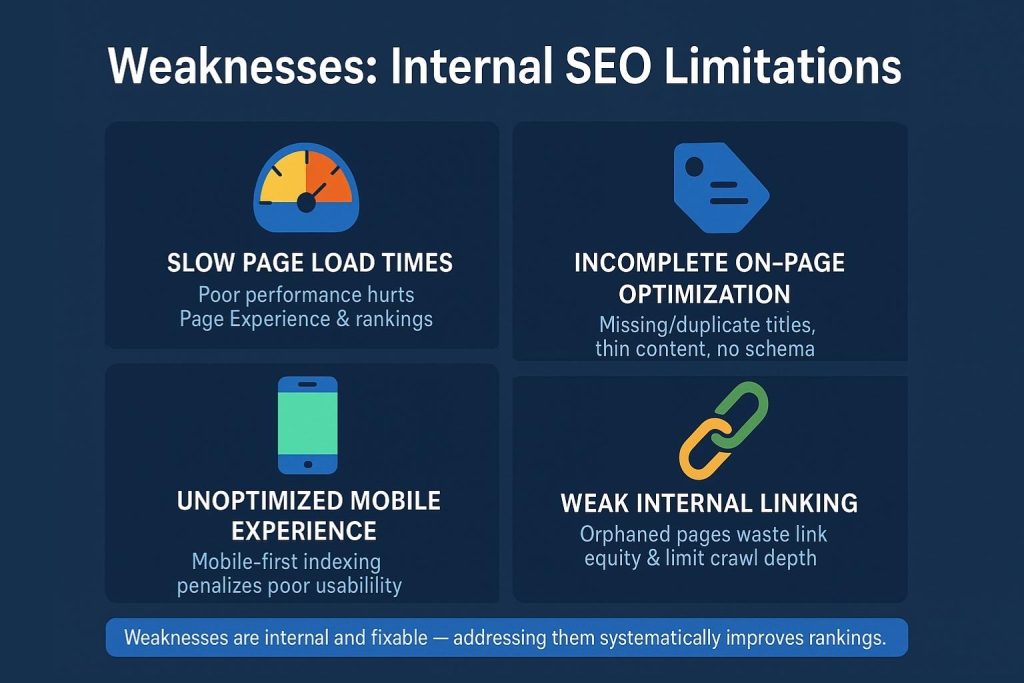
Why Weaknesses Are Critical to Address
If you ignore these, they compound over time. For instance, poor internal linking combined with thin content creates a visibility bottleneck, reducing the ROI of your content investments. Weaknesses often emerge during technical audits, but a SWOT approach prioritizes which issues matter most for overall business goals.
The Backlink Lens in SEO SWOT Analysis
Backlinks remain a critical factor in SEO, so it’s useful to consider them through each quadrant of SWOT:
- Strengths: High-quality, relevant backlinks from authoritative sites reinforce domain authority and topical relevance.
- Weaknesses: Toxic or irrelevant backlinks flagged in GSC can hurt rankings and waste crawl budget.
- Opportunities: Digital PR, HARO contributions, and broken link building create new pathways for authority growth.
- Threats: Negative SEO campaigns, spammy link schemes, or Google link spam updates can quickly erode rankings.
This ensures your analysis accounts for one of the most powerful and risky SEO levers.
Opportunities: External SEO Growth Levers
Opportunities are external factors that you can capitalize on to accelerate growth. This is where SEO opportunity analysis becomes critical, as it helps you uncover emerging search trends, competitor gaps, or changes in search engine behavior.
Sources of SEO Opportunities
- Keyword Gap Analysis: There are many Keyword Gap tools that reveal terms competitors rank for that you do not.
- Unclaimed SERP Features: Featured snippets, People Also Ask boxes, and video carousels represent untapped traffic potential.
- International SEO Expansion: Entering new markets with localized content offers exponential growth possibilities.
- Voice Search Optimization: With voice queries increasing, optimizing for conversational keywords can position your site for future traffic.
- Emerging Technologies: Structured Data and AI-generated summaries present new visibility opportunities.
Strategic Evaluation of Opportunities
Not all opportunities are worth pursuing. Prioritize based on:
- Impact: Will this drive meaningful traffic or conversions?
- Feasibility: Do you have the resources and authority to capture this opportunity?
- Alignment: Does it align with your business objectives and audience needs?

For example, adding structured data for product listings might produce immediate gains in eCommerce visibility, whereas creating a podcast may not be worth the investment if your audience prefers written content.
Threats: External SEO Risks
Threats are external conditions that could negatively affect your SEO performance. They are often beyond your control, but can be mitigated with preparation.
Common SEO Threats
- Algorithm Updates: Changes like Google’s Helpful Content Update can impact entire content strategies.
- Competitor Escalation: If competitors ramp up content production or invest in high-authority backlinks, your relative visibility decreases.
- SERP Feature Volatility: Google may add ads or zero-click features that reduce organic CTR.
- Market Dynamics: Shifts in user behavior or seasonal demand can affect keyword performance.
Proactive Measures Against Threats
- Monitor ranking fluctuations with Rank Ranger or Ahrefs.
- Diversify content formats to avoid overreliance on one SERP type.
- Build resilience with omnichannel strategies, such as email capture, to reduce dependency on organic traffic.
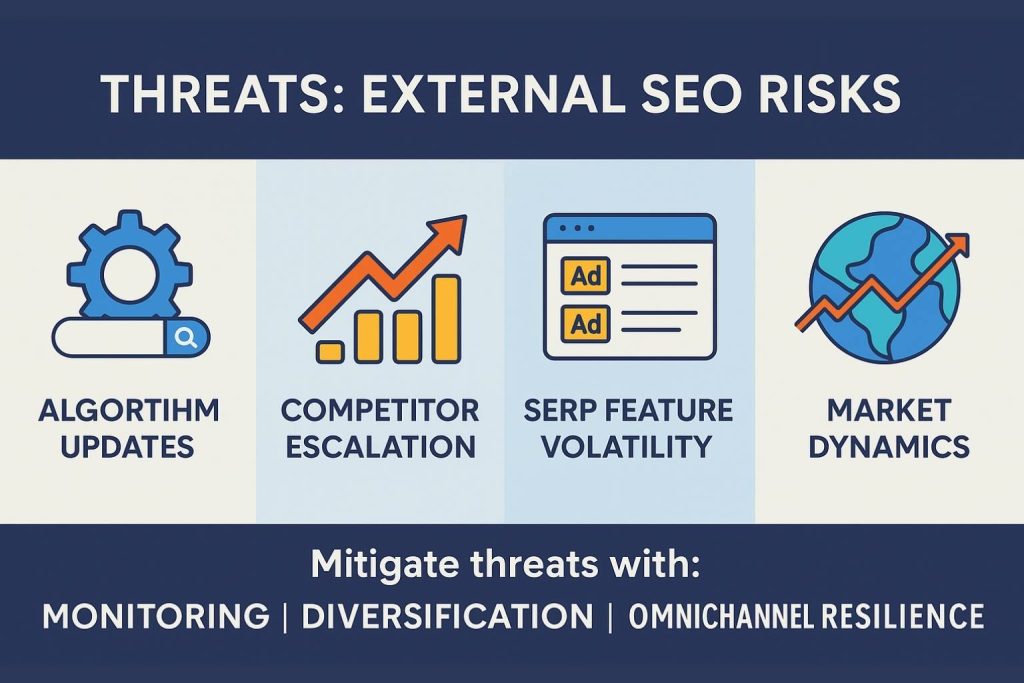
Understanding threats ensures your SEO strategy is not just about growth but also about risk mitigation.
Why These Components Matter Together
A single dimension does not provide clarity. A technically perfect site with a poor content strategy will underperform. Similarly, strong content without authority will fail to compete in competitive niches. The true power of SEO SWOT analysis lies in combining these quadrants to craft a roadmap that leverages strengths, corrects weaknesses, seizes opportunities, and neutralizes threats.
SEO TOWS Matrix (Strategic Application of SWOT)
While SWOT helps you categorize insights, the TOWS Matrix takes it further by aligning internal and external factors into actionable strategies.
| TOWS Strategy | SEO Example |
| SO (Strengths + Opportunities) | Use a strong domain authority (Strength) to target emerging AI/voice search queries (Opportunity). |
| WO (Weaknesses + Opportunities) | Fix thin product descriptions (Weakness) to capture long-tail commercial keywords with high intent (Opportunity). |
| ST (Strengths + Threats) | Leverage your strong backlink profile (Strength) to defend against SERP volatility and ads that reduce CTR (Threat). |
| WT (Weaknesses + Threats) | Resolve crawl inefficiencies (Weakness) to reduce vulnerability to future Google Core updates (Threat). |
This approach transforms your SWOT into a roadmap of defensive and offensive SEO strategies.
How to Perform an SEO SWOT Analysis: Step-by-Step Framework
Conducting a SWOT analysis for SEO involves more than filling out four boxes; it requires structured data, prioritization, and alignment with business goals. It requires a structured process, data-driven insights, and prioritization. Below is a framework we use for complex SEO environments, whether for enterprise sites or large-scale campaigns.
Step 1: Define Clear Objectives and KPIs
Before gathering data, define what success looks like. Are you aiming to:
- Increase organic revenue by a certain percentage?
- Capture SERP features in a specific product category?
- Expand international visibility in targeted markets?
Your objectives will dictate which metrics and data points you analyze. For example:
- E-commerce sites might focus on revenue per organic visit and conversion rate.
- Content publishers prioritize impressions, CTR, and engagement metrics.
- Local businesses track rankings in geo-specific searches and Google Business Profile visibility.
Setting clear KPIs like share of voice, domain authority benchmarks, or percentage increase in organic conversions ensures that the SWOT analysis produces actionable insights aligned with business goals.
Step 2: Gather Comprehensive SEO Data
Data accuracy determines the value of your analysis. Pull information from multiple sources to cover technical, content, and competitive aspects.
Data Sources and Tools
- Technical Health: Use Screaming Frog, Semrush, or Ahrefs for crawl analysis.
- Performance Metrics: Pull impressions, CTR, and top queries from Google Search Console.
- Content Analysis: Evaluate keyword distribution and topical clusters with Semrush and Ahrefs.
- Backlink Profile: Review link authority and toxicity using Ahrefs or Majestic.
- Competitive Benchmarking: Compare keyword gaps and domain visibility via Semrush.
Data Organization
Use a spreadsheet, dashboard, or an online SWOT analysis tool to organize your findings under four headings: strengths, weaknesses, opportunities, and threats. Visualization tools like Lucidchart or Looker Studio can help present this information clearly.
Mapping SEO Tools to SWOT Quadrants
| Tool | Data Extracted | SWOT Quadrant |
| Google Search Console | Queries, CTR, impressions, coverage reports | Strengths / Weaknesses |
| Lighthouse / PageSpeed Insights | Core Web Vitals, performance issues | Weaknesses / Threats |
| Semrush / Ahrefs | Keyword gaps, competitor visibility | Opportunities |
| Majestic / Ahrefs / GSC Links | Backlink quality & toxicity | Strengths / Weaknesses |
| GA4 | Conversion rates, engagement metrics | Strengths / Weaknesses |
This makes your framework practical, data-driven, and tool-agnostic.
Step 3: Analyze and Categorize Findings
Once data is collected, classify insights into the four SWOT quadrants.
Example Process
- Strengths: Identify pages or domains with strong backlink equity, high organic CTR, and low bounce rates.
- Weaknesses: Flag crawl errors, thin content, or missing structured data.
- Opportunities: Highlight keyword clusters competitors rank for that you do not, and evaluate potential for featured snippets.
- Threats: Note emerging competitors, aggressive PPC bidding on organic keywords, or SERP changes reducing organic clicks.
Avoid vague entries. For example, instead of writing “slow site speed” under weaknesses, specify: “LCP exceeds 4 seconds on 38% of URLs” based on Core Web Vitals.
Step 4: Prioritize Based on Impact and Effort
Not all issues or opportunities carry the same weight. To avoid wasted resources, evaluate each initiative by considering:
- Impact: How much the action could influence rankings, traffic, or conversions.
- Effort: The resources, time, and complexity required to implement it.
For example:
- Adding schema to product pages might be high-impact and relatively easy to execute.
- Building 500 backlinks could also be high-impact but far more resource-intensive.
By weighing actions against both their potential payoff and the effort required, you can ensure your roadmap emphasizes the initiatives that deliver the strongest return on investment.
Step 5: Develop an Actionable SEO Roadmap
A SWOT analysis is only useful if it leads to implementation. Convert findings into structured projects:
- Assign owners and timelines.
- Link each task to a KPI.
- Use project management tools like Asana or Monday.com for tracking.
For example:
- Task: Implement FAQ schema on 20 high-traffic informational pages.
- KPI: Increase featured snippet visibility by 15% within 60 days.
Step 6: Visualize and Communicate Findings
Executive teams and cross-functional stakeholders often lack SEO expertise, so visualization matters.
- Once you create a SWOT analysis, present the four quadrants in a clear chart format using Canva or PowerPoint for stakeholder communication.
- Include supporting charts: keyword gap analysis, backlink distribution, and traffic growth forecasts.
- Highlight business implications, such as projected revenue from opportunity clusters.
This step transforms the analysis from a technical report into a strategic asset that drives organizational buy-in.
Step 7: Review and Update Quarterly
SEO is dynamic. Opportunities and threats evolve as algorithms, competitors, and user behaviors change. Schedule quarterly SWOT reviews and adjust the roadmap accordingly.
- Compare historical SWOT snapshots to track progress.
- Identify patterns in recurring weaknesses or emerging opportunities.
- Adjust KPIs if market conditions shift, such as seasonal demand or industry disruptions.

Example Workflow Summary
Here’s a condensed version of the process:
- Define objectives and KPIs.
- Gather data across technical, content, and competitive dimensions.
- Categorize insights into SWOT quadrants.
- Score items by impact, confidence, and effort.
- Build a roadmap with clear timelines and KPIs.
- Visualize findings for stakeholders.
- Reassess quarterly for continuous improvement.
Quick-Start SEO SWOT Checklist
If you’re new to conducting a SWOT analysis in SEO, here’s a 10-step checklist to get started quickly:
- Export your top-performing queries from Google Search Console.
- Identify your top 10 converting landing pages in GA4.
- Run a Lighthouse audit to check Core Web Vitals (LCP, CLS, FID).
- List the keywords where you rank between positions 3–10 (near wins).
- Note any pages with high impressions but low CTR in GSC.
- Run a competitor keyword gap analysis in Semrush/Ahrefs.
- Review your backlink profile for toxic or irrelevant links.
- Identify featured snippets, PAA, or video SERP features competitors hold.
- Check if mobile usability or structured data errors exist in GSC.
- Document your emerging threats: competitor content surges, SERP ads, or Google updates.
Once completed, drop each finding into the correct SWOT quadrant (Strengths, Weaknesses, Opportunities, Threats) for a structured overview.
Advanced Considerations for Experts
Once you have mastered the basics of SEO SWOT analysis, the next step is to enhance its strategic value with advanced techniques. These considerations help elevate your analysis beyond tactical recommendations and into predictive planning. For global organizations, incorporating multilingual evaluations like an Analyse SWOT en SEO can help capture opportunities in non-English markets and mitigate region-specific threats.
Integrate Predictive Analytics
Instead of treating SWOT as a static snapshot, use historical data to forecast performance trends. For example:
- Combine past ranking volatility data with Google algorithm update history to predict potential risk zones.
- Apply machine learning models in tools like Google BigQuery or Tableau for traffic forecasting based on identified opportunities.
Layer Entity-Based SEO
Search engines increasingly rely on semantic understanding. Incorporate entity-based optimization into your SWOT framework by analyzing:
- Content gaps around key entities using tools.
- Opportunities to strengthen internal linking through contextual entity mentions.
This improves your ability to capture featured snippets and Knowledge Graph visibility.
Correlate with Conversion Metrics
Traditional SWOT focuses on traffic, but experts should tie opportunities and threats to revenue impact. Example approach:
- Map identified keyword gaps to funnel stages and conversion rates.
- Calculate potential ROI for each opportunity cluster to prioritize effectively.
Expand SWOT for Global SEO
If you manage international markets, adapt your analysis for language and location variations:
- Use hreflang audits to ensure proper targeting.
- Evaluate competitor activity in local search engines like Yandex or Baidu.
This approach uncovers unique threats and opportunities in regional SERPs.
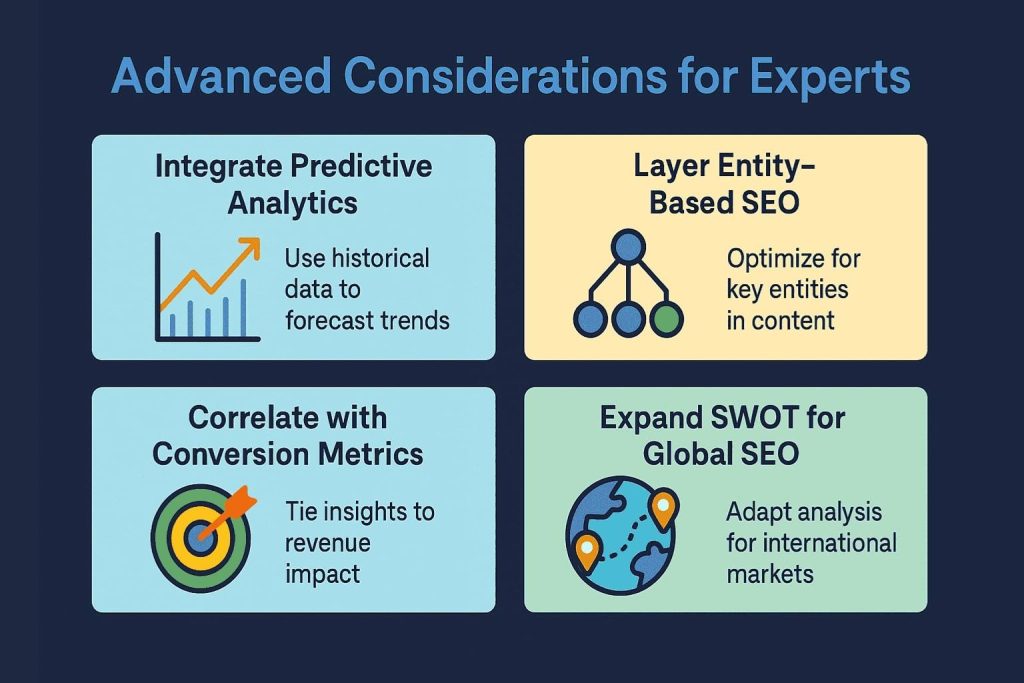
Common Mistakes When Conducting an SEO SWOT Analysis
Even experienced SEO professionals can make critical errors during this process. Here are the most frequent mistakes and how to avoid them:
1. Treating SWOT as a One-Time Task
SEO environments evolve rapidly. Failing to update your SWOT quarterly makes your insights obsolete and can lead to misaligned strategies.
2. Overloading with Generic Data
Listing vague entries like “improve content” under weaknesses provides no actionable direction. Use specific, measurable points, such as “40% of pages lack optimized H1 tags.”
3. Ignoring Competitive Intelligence
An internal-only analysis overlooks market dynamics. Use competitive research tools like Semrush and Ahrefs to identify external risks and opportunities.
4. Prioritizing Low-Impact Fixes
Spending months on minor technical errors while overlooking initiatives that directly influence revenue or visibility is a common pitfall. Focus on actions that deliver meaningful business outcomes rather than getting lost in low-value tasks.
5. Poor Stakeholder Communication
Failing to translate technical findings into business language limits executive buy-in. Always include a business impact section in your report.
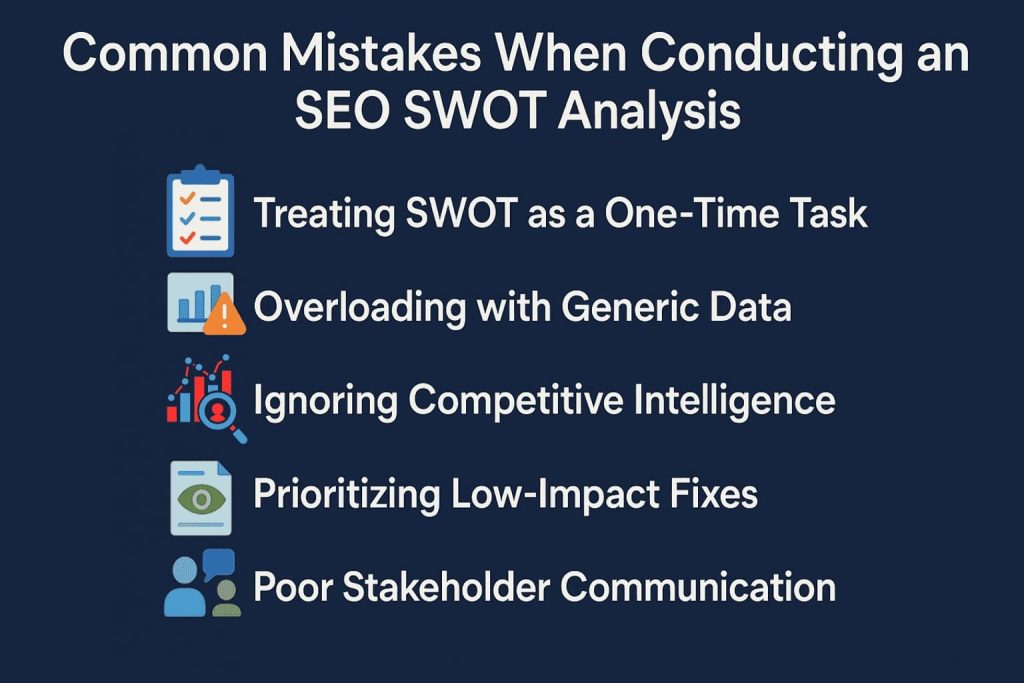
FAQs on SEO SWOT Analysis
Q1: How often should I conduct or update an SEO SWOT analysis?
A: An SEO SWOT analysis should be conducted and updated at least quarterly in highly competitive industries, and biannually in more stable niches. Regular updates ensure alignment with algorithm changes, competitor activity, and emerging opportunities in search visibility.
Q2: Is an SEO SWOT analysis different from a general SWOT analysis?
A: Yes. A traditional SWOT analysis evaluates overall business performance, while an SEO SWOT analysis is specifically focused on technical health, content authority, search visibility, and competitive positioning within search results.
Q3: What tools are essential for this process?
A: Essential tools include Screaming Frog for technical audits, Google Search Console for performance data, Ahrefs and Semrush for keyword and backlink insights, and Looker Studio for visualization. These provide the data needed to classify strengths, weaknesses, opportunities, and threats.
Q4: Can an SEO SWOT analysis help predict Google algorithm updates?
A: While it cannot directly predict updates, an SEO SWOT analysis highlights vulnerabilities such as over-optimized anchor text or thin content, which often lead to ranking losses during updates. Proactively addressing these weaknesses reduces risk.
Q5: How do I turn SWOT insights into an actionable roadmap?
A: The findings from a SWOT analysis should be directly tied to KPIs, assigned clear owners, and translated into a roadmap within project management tools. To maximize impact, evaluate each initiative based on its potential business value and the effort required to execute. This helps ensure resources are focused on the opportunities and fixes most likely to drive measurable growth.
Q6: How do you conduct a SWOT analysis for a website?
A: Conducting a website SWOT analysis involves defining SEO objectives, gathering performance data from tools such as Google Search Console, Lighthouse, and Semrush, and classifying findings into strengths, weaknesses, opportunities, and threats. Insights are then prioritized and translated into an actionable SEO roadmap.
Q7: What’s the difference between SEO SWOT and an SEO audit?
A: An SEO audit identifies technical or content-related issues but does not prioritize them in a strategic context. An SEO SWOT analysis extends further by mapping those findings against business objectives and market conditions, ensuring decision-makers focus on what delivers the greatest impact.
Final Thoughts
A thorough SEO analysis, especially one using a SWOT framework, is more than a reporting tool; it’s a strategic asset that aligns SEO efforts with business goals. It is a strategic framework that aligns SEO initiatives with business objectives, identifies growth opportunities, and mitigates risks in a constantly evolving search environment. When executed correctly, it transforms raw data into actionable strategies, giving you clarity and a competitive advantage.
This approach ensures your SEO strategy remains proactive, focused, and adaptable to market changes. Incorporating regular SWOT analyses is essential for sustainable success and should be a core part of your workflow. When integrated into a broader marketing strategy, it unlocks cross-channel growth and positions your organization for long-term competitive advantage. Pairing SWOT insights with executive-level marketing leadership transforms isolated tactics into measurable results.
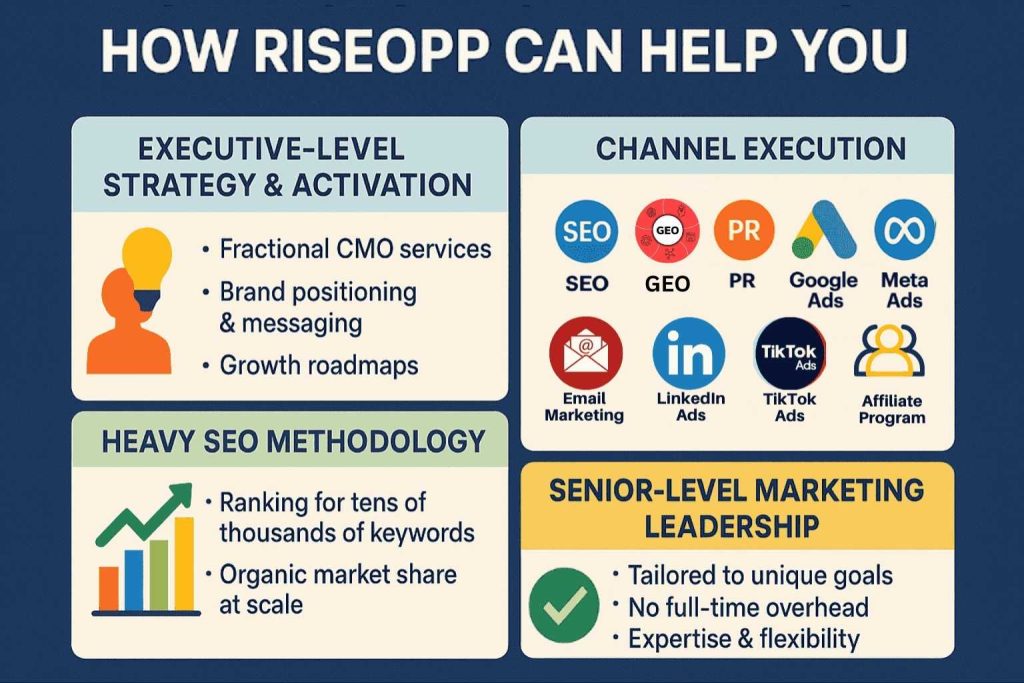
How RiseOpp Can Help You Turn SEO SWOT Insights into Scalable Growth
RiseOpp works with businesses across industries to turn strategic insights into measurable growth. We bridge the gap between high-level marketing leadership and disciplined execution, enabling organizations to transform SEO and marketing from isolated activities into a unified growth engine.
What sets our approach apart is the combination of executive-level strategy and hands-on activation. Through our Fractional CMO services, we guide companies in developing brand positioning, refining messaging, and building comprehensive growth roadmaps. At the same time, we execute across channels, including SEO, GEO, PR, Google Ads, Meta Ads, LinkedIn Ads, TikTok Ads, email marketing, and affiliate programs, ensuring strategies don’t stay theoretical.
Our proprietary Heavy SEO methodology gives businesses a distinct advantage. By focusing on ranking for tens of thousands of keywords over time, we enable companies to dominate competitive landscapes and capture organic market share at scale. This methodology aligns perfectly with the insights gained from an SEO SWOT analysis, turning identified opportunities into sustained visibility and revenue.
When you partner with RiseOpp, you gain more than tactical execution. You get senior-level marketing leadership tailored to your unique goals without the overhead of a full-time executive. Whether you are scaling aggressively, entering new markets, or future-proofing your SEO in an AI-driven era, we deliver the expertise, structure, and flexibility needed to achieve measurable results.
If you’re ready to move beyond isolated tactics and build a strategic foundation for long-term growth, contact us today to explore how RiseOpp can help transform your marketing.
Comments are closed